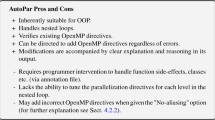Abstract
The exponential growth of computer power in the last 10 years is now creating a great challenge for parallel programming toward achieving realistic performance in the field of scientific computing. To improve on the traditional program for numerical simulations of laser fusion in inertial confinement fusion (ICF), the Institute of Applied Physics and Computational Mathematics (IAPCM) initializes a software infrastructure named J Adaptive Structured Meshes applications INfrastructure (JASMIN) in 2004. The main objective of JASMIN is to accelerate the development of parallel programs for large scale simulations of complex applications on parallel computers. Now, JASMIN has released version 1.8 and has achieved its original objectives. Tens of parallel programs have been reconstructed or developed on thousands of processors. JASMIN promotes a new paradigm of parallel programming for scientific computing. In this paper, JASMIN is briefly introduced.
Similar content being viewed by others
References
Dongarra J. The international top 500 list for computers. http://www.top500.org
Benioff M R, Lazowska E D. Reports of president’s information technology advisory committee (PITAC), computational science: ensuring America’s competitiveness. June 2005
Lawrence Livermore national laboratory. LLNL computation directorate annual report 2007, UCRL-TR-402150. 2007
Dimitri F K. Advanced simulation & computing: the next ten years, a publication of the office of advanced simulation & computing, NNSA Defense Programs. 2009
Post D E, Votta L G. Computational science demands a new paradigm. Physics Today, 2005, 58(1): 35–41
Sarkar V, Harrod W, Snavelg A Z. Software challenges in extreme scale systems. Journal of Physics: Conference Series, 2009, 180(1):012045
Zhu S. A brief report on scientific computing. Physics, 2009, 38(8): 545–551 (in Chinese)
Mo Z, Pei W. Scientific computing application codes. Physics, 2009, 38(8): 552–558 (in Chinese)
Gropp W, Lusk E, Skjellum A. Using MPI: portable parallel programming with the message-passing interface. 2nd ed. Cambridge: MIT Press, 1999
Dongarra J, Luszczek P, Petitet A. The LINPACK benchmark: past, present, and future. Concurrency (Chichester, England), 2003, 15(9): 803–820
PETSc. https://www.mcs.anl.gov/petsc/petsc-as, May 31, 2010
SAMRAI. https://computation.llnl.gov/casc/SAMRAI, May 31, 2010
BoxLib. https://ccse.lbl.gov/Software/index.html, May 31, 2010
UG. http://www.iwr.uni-hdidelberg.de/groups/techsim, May 31, 2010
Mo Z, Zhang A, eds. User’s guide for JASMIN, Technical Report No.T09-JMJL-01, 2009. https://www.iapcm.ac.cn/jasmin
HDF5. https://www.hdfgroup.org/HDF5, May 31, 2010
Mo Z, Zhang A, Wittum G. Scalable heuristic algorithms for the parallel execution of data flow acyclic digraphs. SIAM Journal on Scientific Computing, 2009, 31(5): 3626–3642
Karypis G, Kumar V. Graph partitioning techniques for high performance scientific simulations. In: Dongarra J, Foster I, Fox J, et al, eds. Sourcebook of Parallel Computing. San Francisco: Morgan Kaufmann Publisher, 2003
Mo Z, Zhang B. Multilevel averaging weight method for dynamic load imbalance problems. International Journal of Computer Mathematics, 2001, 76(4): 463–477
SUNDIALS. https://computation.llnl.gov/casc/sundials/main.html, May 31, 2010
Hypre. https://computation.llnl.gov/casc/linear_solvers/sls_hypre.html, May 31, 2010
Pei W. The construction of simulation algorithms for Laser Fusion. Communication in Computational Physics, 2007, 2(2): 255–270
Author information
Authors and Affiliations
Corresponding author
Rights and permissions
About this article
Cite this article
Mo, Z., Zhang, A., Cao, X. et al. JASMIN: a parallel software infrastructure for scientific computing. Front. Comput. Sci. China 4, 480–488 (2010). https://doi.org/10.1007/s11704-010-0120-5
Received:
Accepted:
Published:
Issue Date:
DOI: https://doi.org/10.1007/s11704-010-0120-5




